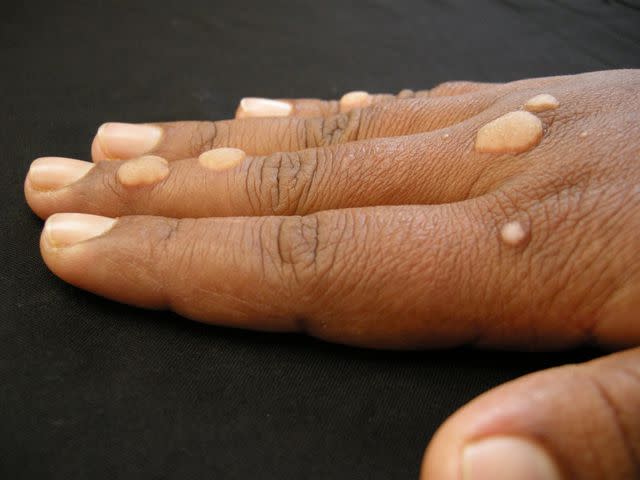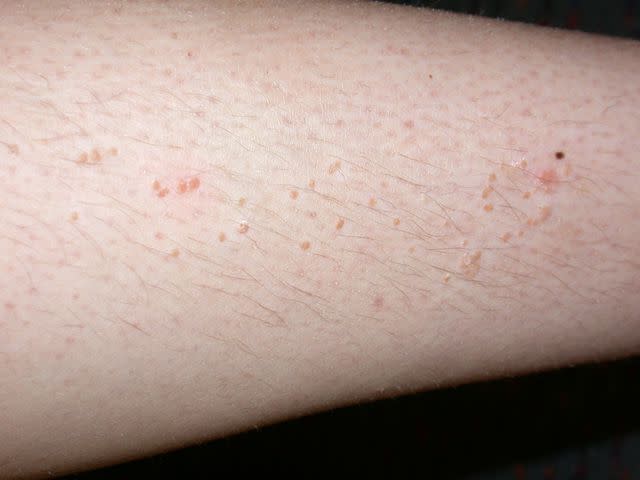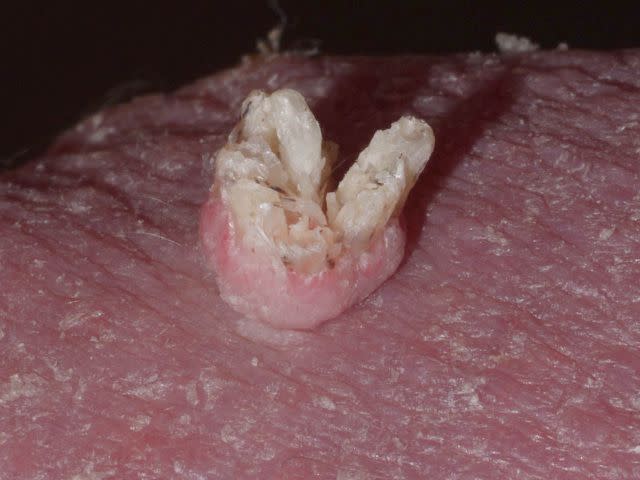5 Types of Warts You Might Get
Medically reviewed by Susan Bard, MD
Warts are non-cancerous skin growths caused by infection of the human papillomavirus (HPV). There are more than 100 types of HPV, but only a few of them cause warts.
Warts are common, especially among children and teenagers. In fact, it's estimated that up to a third of children and teenagers have warts. While warts may be annoying, they’re generally harmless. Warts are contagious through both direct and indirect contact, though, so treating them and preventing their spread is key.
Different types of HPVs can cause different types of warts. The different types of warts can affect different parts of the body and look different from each other. The might also be treated in different ways.
Common Warts

DermNet
Common warts are most often found on the fingers, knees, and back of the hands. They can also be found around nails. Warts close to the fingernails are called periungual, and warts close to the toenails are called subungual.
Common warts tend to be small, round, and rough. They might have small black dots that look like seeds. The dots are actually clogged blood vessels within the skin affected by the wart. These are called seed warts.
Common warts may form where the skin has been injured or damaged and HPV has since infected the wound. Common warts occur frequently in children and people with weakened immune systems.
Plantar Warts

DermNet
Plantar warts are extremely common, affecting about 14% of children and adults each year. This type of wart is found on the soles of the feet. Plantar warts are one of the harder types of warts to treat, partially because the pressure you place on your feet during the day pushes the warts inward. This can also make plantar warts uncomfortable, tender, or even painful when you walk.
They often start out looking like callused patches of skin, but they may have small black dots within the wart itself. Plantar warts can cluster together. When they do, this is referred to as mosaic warts.
Related: 7 Infections You Can Catch at the Gym
Flat Warts

DermNet
Flat warts most often develop on the face, particularly the forehead. They are common in children and become less prevalent as you get older. It is rare for adults to have them.
When adults get them, they tend to be in areas where you shave. For instance, men usually develop the warts in the beard area while women can get the warts on their legs.
Flat warts are usually skin-colored but can be light brown. They are smaller and smoother than other warts. They may also cluster together and form in groups of 20 or more.
Filiform Warts

DermNet
Filiform warts have a very notable appearance, forming as clusters of narrow, spiky growths that protrude outward from the surface of the skin. The warts tend to grow quickly on the face, especially near the mouth, nose, and eyes.
Genital Warts
Genital warts are the most common type of sexually transmitted infection, affecting millions of teens and young adults each year. They are small and flesh-colored. They may be flat or rough and bumpy.
They can form inside or around the anus, inside or outside of the vagina, in the cervix, on the penis or scrotum, and anywhere in the groin or thigh area. Genital warts can also develop in oral areas such as the mouth, lips, or tongue.
Usually, people affected by genital warts don’t have other symptoms. If there are other symptoms, they can include bleeding during sex, increased itching or dampness in the genital area, and increased vaginal discharge.
When to See a Healthcare Provider
Warts are not usually a condition that requires medical attention. But if you aren’t sure what type of wart you have, you may want to see a healthcare provider so the growth can be correctly identified.
Someone like a dermatologist can usually look at your wart and tell what type it is based on its location, shape, color, and texture. Rarely they may perform a biopsy to confirm the type of wart. For this, they would remove the wart and send it to a laboratory so it can be looked at under a microscope. They may also request HPV testing to determine the strain of HPV causing the wart.
You may also want to see a healthcare provider if your wart is bothersome to you, either because it’s uncomfortable (it rubs against your clothing or jewelry, for example) or because it’s in a visible location, like your face.
You should also consider seeing a provider if you have:
Multiple warts
A wart that hurts, itches, or bleeds
Diabetes
A wart on your face or genitals
If you're concerned that the wart might actually be another type of skin growth, you should visit a healthcare provider as well.
Related: Skin Lesions: Types, Pictures, Diagnosis, Treatment & More
Getting Rid of Warts
Many warts go away on their own, but this can take a long time. And while you wait, the virus in your wart can spread to other parts of your body and to other people. To prevent that, you'll want to clear up your warts as soon as possible. You may be able to treat your wart at home, or you may want or need to see a healthcare provider for in-office treatment.
Home Care for Warts
Some types of warts can be treated at home with over-the-counter products made with salicylic acid. Salicylic acid softens the skin on and around the wart, breaking it down so it can eventually slough off or be exfoliated away. These preparations are usually available as a gel or liquid that you apply regularly or as a pre-medicated bandage that you wear and change out every few days.
There are also some non-medicated remedies for treating warts at home, like wrapping the wart in duct tape or applying an herbal tincture, like those made from raw garlic or celandine extract. You should always check with a healthcare provider before trying any natural remedy for wart removal, as some may not be safe for everyone.
You should always avoid cutting, clipping, or tearing a wart off your skin, as this could cause damage to the area and lead to infection. People with diabetes should never remove warts from their feet; this can cause permanent nerve damage.
Rather than trying an at-home treatment for warts on your genitals or face, you should see a medical professional for treatment of these types of warts.
Further Treatment
If your wart doesn’t respond to at-home treatments or you have a type of wart that shouldn’t be treated at home, a healthcare provider like a dermatologist can help you.
Common in-office treatments for warts include:
Cryotherapy, or freezing the wart
Electrosurgery and curettage to burn and remove the wart
The application of cantharidin, a medication that causes the wart to blister
Laser treatments or chemical peels
Immunotherapy to help the immune system treat warts
Prescription medications and ointments to inhibit cell growth or stop the virus
Injection with the anti-cancer medication bleomycin to inhibit cell growth
If you have genital warts, a provider will likely recommend one or more prescription medications to stop the spread of your warts. They may also utilize a wart removal technique like cryotherapy.
How to Prevent Warts
Most people come into contact with one of the many strains of HPV often, but if your skin isn’t broken and you practice good skin hygiene, you may not contract an infection in the form of a wart. Still, considering how widespread and contagious HPV is, it’s also possible you’ll end up with a wart at some point.
That said, there are some ways to try to prevent the types of HPV infections that cause warts:
Wash your hands often.
Keep cuts covered or bandaged until they close up.
Avoid walking barefoot through public spaces, especially warm, wet locations like public pools and gyms.
Don’t touch other people’s warts with your bare hands.
Keep your nails and cuticles in good condition.
Avoid sharing razors and nail trimmers with other people.
As for preventing genital warts, safe sex practices can reduce your risk. If you’re sexually active, this may mean limiting the number of partners you have. Using condoms doesn’t fully protect you from contracting HPV. You may want to ask your healthcare provider about receiving an HPV vaccine that protects against genital warts and cervical cancer.
A Quick Review
Warts are caused by the human papillomavirus (HPV). The type of wart you develop depends on which type of HPV you've been infected with. Types of warts include common, plantar, flat, filiform, and genital warts. Each type of wart can appear on a different place on the body and look and feel different. With the exception of genital warts, warts are not usually harmful and resolve on their own over time. If you want to get rid of a wart faster, you can try at-home treatments or see a dermatologist for in-office treatment. Addressing warts can also help prevent their spread, since they are highly contagious.
For more Health news, make sure to sign up for our newsletter!
Read the original article on Health.
